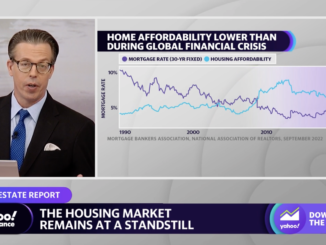
The third quarter of 2023 shows significant shifts in the performance of teams reflecting both the decline in housing sales activity and the pressure on margins occurring throughout the brokerage business, according to the Streamlined Quarterly Team Benchmarking Report, which looked at the financial performance of more than 200 teams across the nation.
This report covers the period from April 1, 2023, to June 30, 2023. In five of the six size categories of teams both gross profit margins and net income margins declined from the second quarter 2023 results.
Steamlined, based in Arizona, has a roster of hundreds of U.S. real estate teams and individual agents as clients for their accounting and bookkeeping services. The firm confirms actual financial and operational details of these businesses and assemble the data in useful benchmark studies to help their clients assess how effectively they are operating.
“This is extremely valuable information, not only for teams but also for the brokerage firms with whom they are affiliated,” says Steve Murray, senior advisor to HW Media. “A clearer understanding of the performance of teams helps everyone understand the impact of the growth of the organization and performance of teams.”
The latest financial insights for the residential real estate teams and agents present a picture of resilience and strategic adaptability, even in the face of shifting economic landscapes.
To note, the financial data sets analyzed in Q3, 2023 are the same number of data sets in Q2, 2023. This consistency is a testament to the solid foundational practices that these businesses have established, which is crucial for long-term sustainability.
Despite the anticipated reconfiguration in revenue streams—with a notable contraction in the number of teams closing between $800,000 to $1.5M in annualized revenue—the broader context remains one of continued activity. This realignment can be viewed as an evolution in market dynamics, with sales dispersing into lower revenue categories (Gross Commission Income), teams and agents are still running profitable companies. For those managing real estate businesses, this signals an environment ripe for strategic repositioning and diversification.
Most teams saw a decrease in gross margin
Teams in five of the six size categories saw a decrease in Gross Margin (GM), with the smallest sized teams (annualized revenues of less than $300,000) having the greatest decline from 83% to 76%.
Teams with annualized revenue between $800,000 and $1.5 million were the only category that experienced an increase, with their GM rising from 65.1% to 67.2% from the second quarter to the third quarter.
“It is normal to have gross margin decline during the course of a calendar year,” says Steve Murray, founder to RTC Consulting and a senior advisor for HousingWire. “As agents grow their volume during the course of a year, the share of gross revenue paid to them rises under most commission plans. This is also in line with what occurs among brokerage companies, in general. The only category that saw a rise ($800,000 to $1.5 million) is also the category that had a significant decline in the number of teams in the category.
“We suspect two things may have happened,” says Murray. “Some teams in this category suffered disproportionately from the decline in sales and dropped down in size leaving a smaller group of better run teams.”
On the other side, a number of these teams grew larger and moved into a larger category. “Weaker firms shrank and stronger teams grew faster than the market,” says Murray. “The remaining teams in the category were the strongest of the category.”
Net income declines
In five of the six categories Net Income (NI) declined with the smallest category of teams seeing the largest absolute decline from 49.3% to 40.6%.
In terms of percentage decline, however, both the smallest teams and those teams with annualized revenues of $1.5 million to $3 million had roughly the same decline of approximately 20%.
The correlation seen in the first two quarters of 2023 remains true for the third quarter. The smallest teams have the highest NI percentage while the largest teams have the smallest NI percentage.
“The combination of the decrease of gross margins and the increase in operating costs had the expected impact of lower profit margins for teams in five of the six categories. The decline in annualized existing home sales also had an impact that may have been the biggest impact.
“The third quarter of a calendar year is normally the highest sales period of the year, but this year, we saw housing sales decline versus both Q2 2023 and Q3 2022,” adds Murray. “Given all these factors it is surprising how durable the results were.”
Shift in teams in each category
One interesting outcome of the Q3 2023 results was the significant shift of the number of teams in each category. For instance, teams in the size category of revenues between $800,000 to $1.5 million declined from 66 in the Q2 2023 to 46 in Q3 2023. Other big movements were that the number of teams with annualized revenue or $300,000 to $550,000 increased by 14, going from 30 to 44. Teams with annualized revenue of $1.5 million to $3 million also increased by eight, going from 45 to 53.
“The significant shift of a large number of teams out of medium-sized teams to both smaller and larger team categories would seem to indicate that not all teams are alike,” says Murray.
“Under the stress of declining home sales and fewer leads at the top of the funnel, some teams owners are as likely to step up their own listings and sales to generate the income to finance their team and their lifestyle. This is not unusual for teams or any real estate agent’s practice.”
Some teams will prosper in this kind of a downturn and others will seek to optimize profit in the short run by cutting costs and increasing personal production rather than by investing scarcer dollars into growth for growth’s sake.
Teams in all six categories had an increase in their operating costs. Teams which had the largest increases in costs were those with annualized revenues between $550,000 – $800,000 (costs up 2.8 points from 30.7% cost of operations to 33.5%) and teams with annualized revenues between $1,500,000 – $3,000,000 which saw their operating costs rise from 29.0% to 31.5%)
Strategic financial oversight at play
The trend towards decreased profitability percentages does not overshadow the evident strategic financial oversight at play. Businesses are clearly demonstrating proactive expense management, an essential skill in ensuring business health. This foresight is particularly evident in the way companies have leveraged the scalability of their variable expenses, ensuring they remain positioned to maintain profitability. This ability to pivot and adapt cost structures in response to revenue fluctuations is a hallmark of agile and forward-thinking businesses.
As presented in the data, an increase in operating expense percentages across all tiers is certainly a challenge; however, it also reflects a calculated investment in two critical growth areas: Salaries and Lead Generation.
By maintaining these areas, businesses are investing in their workforce and future sales pipelines, laying the groundwork for future growth and market share expansion.
Moreover, the minimal fluctuations in general and administrative expenses reveal a tight control over the day-to-day running costs, with businesses showing they can keep a lid on the majority of their expenses despite a tougher economic climate.
Overall, the narrative here is not one of decline but of calculated adjustment and strategic realignment. The real estate businesses that are holding their ground in these times are those that are demonstrating agility, financial acumen, and a commitment to investing in their core assets—people and prospects.
With these strategies in place, there’s every reason to be optimistic about the capacity for real estate businesses to navigate current market shifts successfully and emerge even more resilient.
Streamlined, RTC Consulting and HWMedia are teaming up to share this data with our readers to help create transparency in the results of over 200 teams. We will publish these results on a quarterly basis roughly 45 days after the end of each calendar quarter.
David Pittiglio is the CEO of Streamlined Business Solutions.



